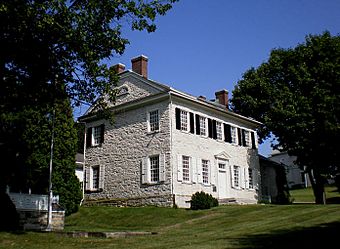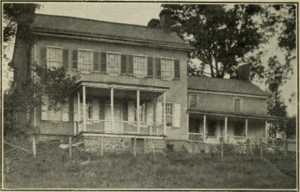George Taylor House (Catasauqua, Pennsylvania) facts for kids
|
George Taylor House
|
|

George Taylor home in Catasauqua, Pennsylvania, August 2008
|
|
| Location | Lehigh & Poplar Sts., Catasauqua, Pennsylvania |
|---|---|
| Built | 1768 |
| Architectural style | Georgian |
| NRHP reference No. | 71000709 |
Quick facts for kids Significant dates |
|
| Added to NRHP | July 17, 1971 |
| Designated NHL | July 17, 1971 |
The George Taylor House is a historic home in Catasauqua, Pennsylvania. It was once the home of George Taylor, one of America's Founding Fathers. He was famous for signing the United States Declaration of Independence.
George Taylor built this house in 1768. In 1971, it was recognized as a National Historic Landmark. This means it is a very important place in American history.
Today, the Borough of Catasauqua owns the house. They bought it in 2009. The borough now hosts events and offers tours. You can visit this historic site near the Lehigh River Canal.
Contents
Early Owners of the House
The first three owners of the George Taylor House were important men. They played big roles in local and national events. These events led to the founding of the United States.
George Taylor: 1768–1776
George Taylor was born in Northern Ireland in 1716. He moved to the American colonies in 1736. He started as an indentured laborer, which meant he worked for someone for a set time to pay for his trip.
He became a successful ironmaster, someone who manages ironworks. He worked at iron furnaces in Pennsylvania. In 1767, Taylor bought a large property in Biery's Port. This area is now part of Catasauqua.
On this land, he built one of the finest homes in the region. This is the house we now call the George Taylor House. His wife, Ann, passed away shortly after they moved in. Taylor lived there for six years.
In 1774, he moved back to Durham. He managed the ironworks there. Before the war, the Durham Furnace made things like stove plates and cooking pots. When the Revolutionary War began in 1775, the mill started making cannon shot. This was for the American army and navy.
Taylor became involved in public service in the late 1750s. He was a justice of the peace, an important judge in colonial times. Later, he was elected to the Pennsylvania Provincial Assembly. He represented Northampton County from 1764 to 1769.
In 1775, he was re-elected to the Assembly. On July 20, 1776, he was chosen for the Continental Congress. Two weeks later, on August 2, he signed the United States Declaration of Independence.
Taylor sold his Biery's Port property in 1776. He sold it to John Benezet of Philadelphia. In March 1777, Taylor joined Pennsylvania's new Supreme Executive Council. This group of 12 members acted like a governor.
Taylor resigned after a few months due to poor health. He stopped his public career. He continued making iron for three more years. Then he retired to Easton in 1780. He passed away on February 23, 1781, at age 65.
John Benezet: 1776–1782
John Benezet was from Philadelphia. His father was a well-known merchant. John briefly attended the College of Philadelphia. He was also elected to the American Philosophical Society in 1768.
In 1775, he married Hanna Bingham. His father gave him money and stock to start an import business. On March 27, 1776, Benezet bought George Taylor's estate. He paid £1,800 for it.
Benezet, like Taylor, was briefly involved in politics. In 1775, he was a secretary at the Pennsylvania Provincial Congress. Taylor also attended this meeting. In August 1775, Benezet joined Philadelphia's Committee of Correspondence.
In 1777, the Continental Congress appointed Benezet as Commissioner of Claims. This was in the Treasury Office. However, he resigned in 1778 to focus on his business. Benezet died in the winter of 1780–81. His ship, the Shillelagh, was lost at sea on a trip to France.
David Deshler: 1782–1796
In 1782, Benezet's widow sold the Biery's Port estate to David Deshler. She sold it for the same price her husband had paid. Deshler was born in Switzerland in 1734. He came to the American colonies as a baby.
His father, Adam Deshler, was one of the first residents of northern Lehigh County. Adam owned a lot of land. He built Fort Deshler in Whitehall Township in 1760. This fort protected local settlers from Native American attacks.
When David Deshler bought Taylor's former house, he lived in Northampton Town. This town is now Allentown. Deshler built the town’s first house in 1762. He first ran a store and tavern there. Later, he started a saw mill and a grist mill. These were Northampton Town's first industries. By the mid-1770s, he was one of the richest men in the area.
In 1774, Deshler joined the county's Committee of Observation. Two years later, he was elected to the Pennsylvania Provincial Assembly. He served there with George Taylor. During the Revolutionary War, Deshler's properties helped the Continental Army. They produced supplies and stored materials.
In 1777, the Assembly made him one of four "sub-lieutenants." They were in charge of the county's military preparations. Deshler was a colonel in the militia. He was named a Commissioner of Purchases in 1778. He also became an Assistant Forage Master in 1780.
The war ended in 1783. The next year, Deshler was re-elected to the Provincial Assembly. In 1787, he was a delegate to the state convention. This convention approved the federal Constitution. After his last term in 1788, he retired from public service. Deshler lived at his Biery's Port estate until he died. He passed away on December 24, 1796, at age 62.
The 1800s and 1900s

During the 1800s, the George Taylor House had many different owners. Eventually, the Wahneta Silk Company bought it. They built a mill in front of the house around 1890. For many years, the property was not well cared for.
In 1945, the Lehigh County Historical Society saved the house. They raised money from their members to buy it and make repairs. Since then, the historical society has done a lot of work to restore the house.
National Historic Landmark Status

On July 17, 1971, the George Taylor House was officially named a National Historic Landmark. In 1982, a fire destroyed the old silk mill. It was a furniture factory at that time. After the fire, the historical society bought the land. They extended the front lawn. This created a park-like setting for the historic site.
In 2008, the society suggested selling the house to the Borough of Catasauqua. They asked for $250,000. The society believed the borough could do more with the site. They thought it would be great for community events.
On May 5, 2013, a special monument was unveiled. This happened during the Lehigh County Bicentennial celebration. Jirair Youssefian designed the monument. It is on the front lawn of the house. This monument will be the base for a future statue of George Taylor. The statue is currently being planned.



